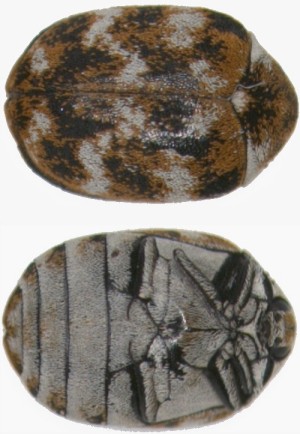Dermestid Carpet Beetles
 Damage
Damage
Carpet beetles feed on animal and plant substances such as wool, fur, feathers, hair, hides, horns, silk, and bone as well as cereals, cake mixes, red pepper, rye meal, and flour. Other food sources include powdered milk, dog and cat food, leather, book bindings, dead insects, and even cotton, linen, and rayon when stained with spilled foods or animal excreta. The larvae cause the damage, crawling from room to room and living behind baseboards and moldings, and in air ducts, dresser drawers, carpets, clothing, and furniture. Adult beetles fly readily and may be found outdoors feeding on pollen, especially on plants with white or cream colored flowers. Some adult beetles are attracted to flowering plants close to homes and can easily enter through small openings. Some infestations are started by adult carpet beetles that fly from house to house. Also, carpet beetles breed and feed outdoors in places such as bird and rodent nests. Eggs and larvae may be carried into homes on articles containing wool or other animal fibers. The articles on which they hitchhike most commonly are secondhand clothing, upholstered furniture, and material such as woolen scraps (as for rug or quilt making).
Life Cycle
All carpet beetles pass through four stages: egg, larva, pupa, and adult. Adults fly readily and during warm sunny days feed outdoors on pollen of various flowers and shrubs, especially spirea and crepe myrtle. Depending on the species, each female may lay 40 to 90 white eggs which hatch in 8 to 15 days. Eggs laid indoors are found in lint accumulations near the food source, in air ducts, under heavy furniture, behind baseboards, etc. After hatching, larvae begin their destructive feeding, avoiding light and molting several times as they develop. They may spend 60 days to a year or more in the larval stage, depending on species, type and amount of food available, and temperature. When rooms are warm indoors, the life cycle is shorter than in an unheated portion of the house during the winter. In the spring, the pupal stage is followed by new adults. The black and varied carpet beetles usually have only one generation per year, but other species may have three or four generations per year.
Description
Black carpet beetle [Attagenus unicolor (Brahm)]. Adults are oval and shiny black with brownish legs. They vary in length from 1/8 to 3/16 inch. Larvae are golden to dark brown and about 1/2 inch long. The body is narrow and elongate and narrows toward the rear. There is a long brush of bristles at the end of the abdomen. This species is common in Oklahoma.
Varied carpet beetle [Anthrenus verbasci (L.)]. Adults are about 1/10 to 1/8 inch long and nearly round. The top surface is usually gray with a mixture of white, brown, and yellow scales and irregular black crossbands. The bottom surface has long, gray-yellow scales. Larvae are about 1/4 inch long and light to dark brown in color. The body is wide and broader at the rear than the front. There are tufts of hair near the tail end. They are very common in Oklahoma.
Furniture carpet beetle [Anthrenus flavipes LeConte]. Adults are about 1/16 to 1/8 inch long, nearly round, and whitish checkered with black spots, each outlined with yellowish orange scales. The bottom surface is white and the legs have yellow scales. Larvae are about 1/4 inch long, elongate-oval, and thickly covered with brownish hair. This species is not common in Oklahoma but has been found on a few occasions.
Common carpet beetle [Anthrenus scrophulariae (L.)]. Adults are about 1/10 to 1/8 inch long, nearly round, and gray to black. They have minute, whitish scales and a band of orange-red scales down the middle of the back and around the eyes. Larvae are similar to those of the varied and furniture carpet beetles. They are not common as far south as Oklahoma but possibly could be found here.
Control
Locate the source of infestation before treatment. Carpet beetle larvae prefer to feed in dark, protected places. Check lint under baseboards, in and under upholstered furniture, in air ducts, in stuffed animals, in stored cereals or grain, in abandoned bird or wasp nests under eaves or in attics, in woolens, in clothes closets, in furs, etc. Also, check all boxes and suitcases in storage areas for the presence of beetles or damage. In all areas, cast skins may be more abundant than larvae. Adult beetles flying around windows may indicate the presence of an infestation. Please contact your local county extension office for current information.

